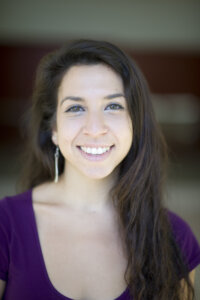In ‘Sh’ma,’ Suki John tells her mother’s story of survival through their shared language of dance. Courtesy of Suki John
Suki John’s war nightmares stopped when she started telling her mother’s story. She’s been telling that story for 35 years, not in words, but in dance.
Her mother, Veronka John-Steiner (nee Polgar) — and her mother’s love for dance — survived the Holocaust, though the war got in the way of her ability to pursue the art form professionally. As a kid, John remembers, they danced the czardas, a Hungarian folk dance, in the living room together. “Every time I had a party in high school, my mother would dance with my friends to my terrible embarrassment,” said John, who nevertheless inherited the passion for movement. She inherited the nightmares, too, as well as resilience and hope.
“I don’t remember when I found out. I feel like I always knew this story,” John told me over Zoom recently, speaking from a small town in France south of Lyon. “Very, very young I felt like I would never lie about being Jewish, that I had to do something with my life, that I had to enjoy my life,” she said. “Because I was alive, in spite of everything.”
Given that her mother was deported from Budapest to Bergen-Belsen as a teenager and her father, a U.S. soldier, fought in the Battle of the Bulge, John said, “I was really statistically unlikely.”
Though her mother took a different path, John did become a professional dancer, a choreographer, and now a longtime professor at Texas Christian University in Fort Worth. Throughout her career, she’s created different iterations of Sh’ma, a choreodrama that tells her mother’s story of survival through their shared language of dance. She first put it onstage in a full-length evening program in Novi Sad in the former Yugoslavia in 1990, shortly before the Bosnian War. She staged it again in New York City in 1999 and 2000, calling it “an artistic triumph and a financial disaster.”
Most recently, she made the dance film Sh’ma: A Story of Survival, reimagining her choreography for a new medium and capturing for posterity a life’s work that was previously ephemeral, lovingly presented each time the lights came up and lost to history every time they went dark. She recently toured the film through Europe.
In college at the University of New Mexico, John discovered that “dance could be about something besides fairies and princesses,” she said. That revelation fueled her “drive to do something with my dancing that had meaning,” she said. Sh’ma — in Hebrew, a command to listen — was it. “If it helps people feel something about this incomprehensible event, then I did something right.”
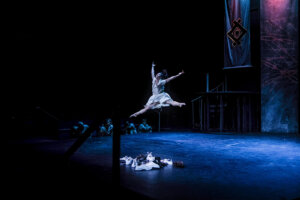
A family history
After her mother passed away in 2017, John knew it was time to revisit Sh’ma.. “When she was dying, children were being separated from their parents” at the border, John said. “My mother started having nightmares again about what she called the night of the knock on the door, of somebody coming to take her away,” she said. John had always thought she would stage Sh’ma again, but now “it felt more urgent.”
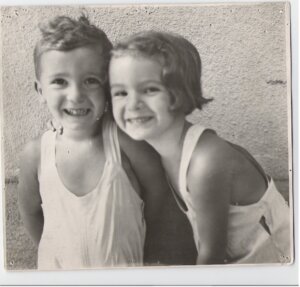
While she planned to revive the work, COVID hit, and with the pandemic came the idea to reimagine Sh’ma as a film, which was ultimately shot in the summer of 2022.
The film follows the teenaged Olya (representing John’s mother), Olya’s brother Sasha, and their parents, a family of assimilated, secular Hungarian Jews living in Budapest during World War II. The father figure, a well-known radiologist, insists they stay put. “My grandfather had fought in World War I for Hungary,” John said. “He thought that he would never be targeted. He felt himself to be very Hungarian.”
The mother implores her husband to leave with the kids while they can, shaking him, gesturing frantically. “They didn’t know how bad it could get,” Samantha Pille, a soloist with Texas Ballet Theater who danced the part of the mother, told me over the phone. Pille, who is not Jewish, learned about the Holocaust growing up in Cincinnati. But the experience of performing in Sh’ma “transformed my basic knowledge that I had, that academic knowledge, into something very visceral.”
Eventually, the family is rounded up and deported to a camp. Upon arrival, guards instruct them to strip and don threadbare schmatta that leave them shivering in the cold. The pile of shoes is a familiar sight. The guards shove the men to the opposite side of the stage. After one character gives birth, tended to by her fellow female prisoners, the guards rip the baby out of her arms. Even in such cruel conditions, Sh’ma’s four protagonists all manage to survive and immigrate to America.
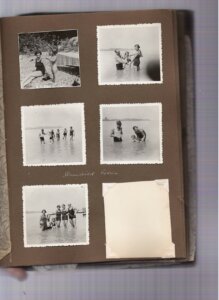
The fascist flags crumple to the ground, replaced in successive scenes by backdrop images of a vast ocean and a city skyline silhouetted against the sun. Survival for the kids and their mother means a second chance at life, but the father is disoriented amid all that hope, stumbling around the stage, unable to join in. He’s wracked with shame and guilt — for thwarting an early escape and for a particularly devastating moment in the camp when, overwhelmed with hunger, he pries a piece of bread out of his own son’s hands. Not long after the war’s end, he kills himself.
To help the dancers embody their roles, John told stories, and brought in books as well as family letters, photos, and recorded interviews. “I can’t know completely the trauma that folks faced in the Holocaust,” said Keith Saunders, John’s colleague at TCU and a Dance Theatre of Harlem veteran who portrayed the father. Just as, he said, “I can’t know completely the trauma that my enslaved ancestors faced.” He drew on his imagination and empathy to “try to pull and depict something that’s truthful to that circumstance.”
He was particularly affected by words John’s grandfather left in a notebook in Hungarian in 1949, the year he took his own life. According to John’s mother, he’d written: “‘A sick person has no right, though he may not be to blame, to wipe off the smile from the faces of those he loves,’” Saunders read aloud to me over the phone. “That spoke a lot to me about his state of mind.”
Despite the tragedy of the war, the camps, and the suicide, “my mother and my grandmother focused on resilience and hope” and “never lost their joie de vivre,” said John, who tried to infuse Sh’ma with all three.
“I used to think strength was portrayed through action,” Pille said. But in Sh’ma, she saw it in the characters’ silent motivation to survive and stick together, she said. “It made me reexamine how I live my own life and how I show up for the people that I love.”
‘Although we say never again…’
The film isn’t meant to be an exact historical retelling. It weaves in scenes that John’s own family never experienced, like a holiday celebration full of folk dances in the ghetto — which they never moved to — and an act of resistance in tribute to events like the Warsaw Ghetto Uprising.
Nor is it intended to realistically depict the places where these events transpired. The entire film was shot within the confines of an empty theater, much of it onstage with a spare set and minimal props, with some scenes making creative use of other spaces. The film opens with the dancers arriving at the theater, dropping duffels, commencing stretches, getting into costume, and framing what follows explicitly as a story they’re telling. A jail scene takes place in a freight elevator. The arduous deportation journey is shot in a grim, crowded back stairwell teeming with ominous shadows, the grandmother figure collapsed on the landing below.
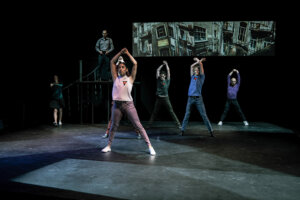
Most importantly, there are no period costumes or swastikas, a deliberate choice on John’s part. She worked with costume and production designers to try to give the work a “timeless aesthetic,” even coming up with a fictional fascist symbol to use in place of Nazi iconography as well as an alternative to yellow stars. “I did not want it to look old,” John said. If it did, she feared, “young people would dismiss it. They’d say, ‘I’ve heard this story. This is not about me. It’s so long ago, and far away.’”
Such reactions would undermine John’s mission not only to educate about the Holocaust at a time of increased distortion, denial, and antisemitism, but also to acknowledge atrocities and oppression beyond the Jewish experience. “It is a personal story that tries to speak to other acts of hate and violence,” John said.
“We’re not the only ones who have been victims of hatred based on our identity,” she said. “The thing I struggled with the most was, how do I tell this particular story and refer to and honor all these other genocides — the Armenian Genocide, the Rwandan genocide, the Bosnian genocide? How do I do this?”
Text on screen tells the viewer that John’s family’s story “echoes the stories of many.” Most of the cast members, like Pille, are not Jewish. John felt diverse casting would help underscore that “although we say never again, things continue to happen in the world that are not equal or the same as, but reminiscent of the horrors of the Holocaust” and in some cases predated it.
“That aspect of the project resonated very profoundly with me,” Saunders said. It “speaks to Suki’s worldview, Suki’s humanity, Suki’s genuine concern and empathy for people everywhere that she very deliberately built in this kind of universality.”
In the final scene, the dancers grasp pieces of chalk and begin to inscribe names on a giant blackboard, crouching or climbing to find an open space. “I had this image of the lists that they would put up in DP and refugee camps of people’s names,” John said. “That turned around to be: We’re going to put up names of people who have been victims of genocide and violence. And I asked the dancers to come up with names that had significance to them.”
John writes her grandfather’s name: Polgar Ferenc. Kira Rai Daniel, the young Black woman and then-TCU student who danced the role of Olya, writes Sandra Bland, Ahmaud Arbery, and Trayvon Martin. “Because we will never forget, shouldn’t forget, and the stories should continue to be told over and over and over again, until the world wakes up,” Daniel told me. “We don’t need to write any more names on this wall.”
‘Because we all have a body’
The film had its premiere at the Museum of Jewish Heritage in New York City in 2023, less than two weeks after Oct. 7. The timing has added another layer of complexity to distributing the film. “Some people don’t want to hear the sad story of the Jews,” John said. “Some people are — I literally had a journalist say to me — ‘tired of the Holocaust.’ Some people are afraid they won’t understand dance. And a lot of people, I think, are just overwhelmed.”
In time, John added a dedication “to the children of Israel and Gaza.” “I have no idea how to fix the Middle East crisis,” John said. “But what I do know is that children are innocent. My mother was innocent when she was deported to Bergen Belsen, and the children of Israel and Gaza are innocent, all of them,” she added. “I wanted to acknowledge them and the pain and suffering that they find themselves in through no fault of their own.”
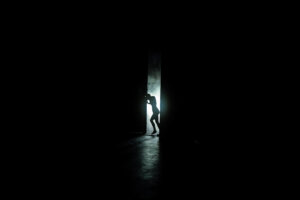
John has been taking an abridged version of the film into high schools throughout Texas, pairing screenings with workshops and educational materials. “I was scared. I thought somebody might want to pick a fight,” she said. But the students have been receptive, and “made some really beautiful poetry and drawings and even some dances in response.”
She’s optimistic that the film’s win for Outstanding Choreography in a Feature Film at the 2025 Chita Rivera Awards — against blockbusters like Wicked and Emilia Perez — will help get Sh’ma into more schools, dance departments, museums, JCCs, museums, movie theaters, and a streaming platform. In the meantime, she remains unwavering in her conviction that dance is “a way to get through to people who maybe tune out with words,” she said, and in her hope that Sh’ma can teach about the Holocaust and human rights.
“My mother used to call dance the language of emotion,” said John, who believes “kinesthetic empathy” makes it particularly powerful. “Because we all have a body, there’s something about watching someone else go through something physically that we can relate to on a very profound level.”
Saunders’ portrayal still makes John cry. “For years, I didn’t really have empathy for my grandfather,” she said, her voice wavering. This experience helped her find more compassion for him, and grapple with longstanding questions about “how some people can move on, and some people just can’t.”
Sharing her family’s story and navigating her own identity as a second-generation survivor through dance has shaped John’s life. And, she said, “it was incredibly healing for me.”
